
By:
Katie
Foster
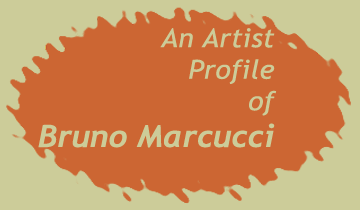

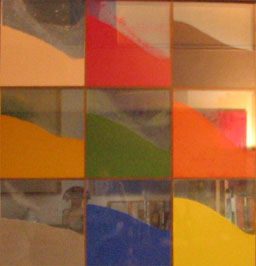
"Sedimenti 1976"
"It's my way of living in the world," describes the Cagliese artist.
Marcucci's work focuses on the study of color, signs, shapes and abstract ideas, a striking contrast from the recognizable images and picturesque scenes of his more famous Italian ancestors--Bernini, Michelangelo, DaVinci.
Leaning against a painted yellow door atop a dark corridor of steps, MarcucciÕs silhouette appears like a mysterious shadow.
"Ciao, ciao, buongiorno, ciao," he greets with a handshake and a smile. As I enter the room, I run my fingertips across the dried paint bubbles on the bright door as if reading passages of braille. The claustrophobic space is filled with stacked shelves and haphazard piles of cds and worn books, waxy green ferns and other leafy plants in white plastic pots, and framed paintings, sketches, and future projects.
"Please sit," he motions, "Would you like some wine?" Smiling, I decline.
Looking the part of a small town Italian artist, Marcucci returns to the kitchen table, his tattered leather loafers collecting dust as they scuff across the tile floor. His bifocals sway on the chain across his chest as he crosses one leg over the other, leans in and waits for my first question.
"What does this one mean?" He doesn't answer.
The subtle sounds of clocks ticking, papers shifting in the wind, and distant motorbikes changing gears deafen my ears while he searches for an answer. He shrugs his shoulders, presses his lips together and holds his palms out as if to say, "I want to know what you think."
This is a common theme found in all of Marcucci's work: giving the viewers a vast freedom to infer their own meaning, if any. Born in Cagli in 1948, Marcucci has known "since always" that art would play a dominant role in his life. After graduating from the Accademia di Belle Arti di Urbino in 1972, he traveled throughout Europe, Africa and the United States honing his craft with such established colleagues as Joseph Beuys and Paolo Paolucci.
Marcucci works on various projects and teaches at the Scuola del Libro, an art school in Urbino. He is president of "Contemporary," a non-profit organization dedicated to promoting awareness and discussing trends of modern thought by organizing concerts, theater events, art exhibits and conventions. In accordance with the values of the group, many of his finished projects foster social awareness and intellectual curiosity.
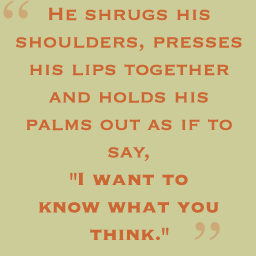
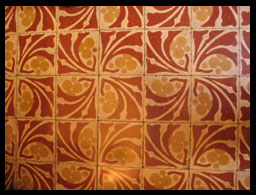
Drag the Mouse Over the Floor Pattern to See Marcucci's Finished Portrait
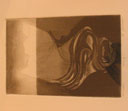



Marcucci
has designed a series of studies on icebergs as part of a collection of
poetry and literature entitled La Voce Secondaria, or The Secondary Voice.
After searching through a drawer beside the table, he pulls out the book
and begins explaining the meaning
behind his images:
Icebergs offer an
interesting glimpse into the nature of personality and thought. They reveal
a mere
1/8th of themselves above water, while the remaining 7/8ths lie in the
hidden depths underneath.
Marcucci's interpretation in black and white demonstrates not only the visual demarcation but also the underlying message of conscious and subconscious, persona and self, facade and truth. My interest in art history and psychology left me eager to learn more. "Molto bene," I say in praise as he holds the original before me.
Although his labors have been displayed in various exhibits, such as his most recent in nearby Loredo, Marcucci understands the various obstacles and limitations that accompany his genre.
"It's not easy to sell my work," he explains, "because not many people like to buy this kind of art." As an abstract artist adept in sculpture, painting, drawing, sketching, and other modern techniques, Marcucci never shies away from complex concepts or materials. Pointing to countless examples scattered around the white-washed walls, he stops on one.
I glance at the salmon-colored pattern interrupted by thick lines of white until he taps me on the shoulder, leads me back into the kitchen and signals at the floor. Like a game of charades, he moves his pointer finger back and forth from the floor to the painting and back again.
In base pigment and egg, Marcucci had transposed the image of light from the window, landing flat on the kitchen floor, into a painting that now hangs on the wall.
Sighing with relief, he stands in front of his bright blue couch with red and yellow pillows and glimpses at his watch. Notebooks fly open, their pages fanning out like a child's pop-up book, while pens and paintbrushes roll back and forth along the edge of his desk. I had taken up enough of his time.
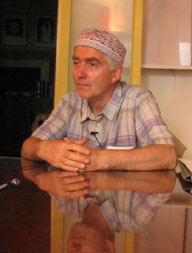
ABOVE:
Marcucci Deep In Thought
LEFT: Some Examples of Marcucci's Work
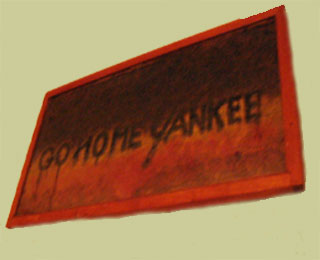
Marcucci explains the history behind the work, mentioning the 68ers and other contextual clues that give sense to the harsh image. The 68ers, according to Marcucci, a previous member, were a mass protest group that formed during the Vietnam War to establish a more peaceful society free from violence, racism and conservative opinion. As evident in all of his paintings, there is always a hidden message beneath even the most seemingly obvious of images.
Like the iceberg in La Voce Secondaria, Marcucci and his work delves deeper than the surface of any canvas. To get the full view you must first peer into the frigid, untravelled waters and explore for yourself. Only then will a true meaning emerge and Marcucci's full talents and passion surface.